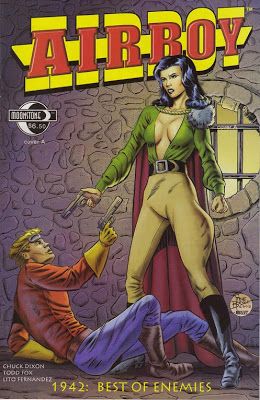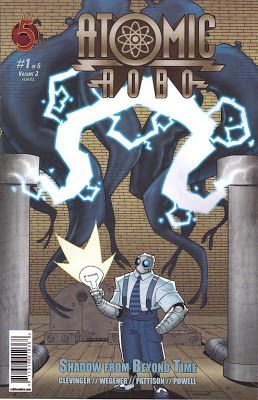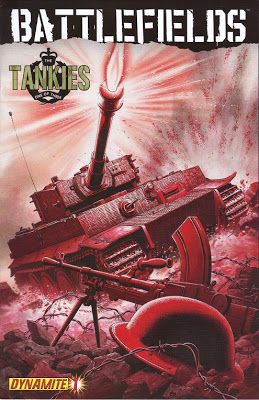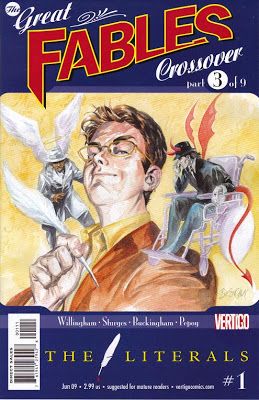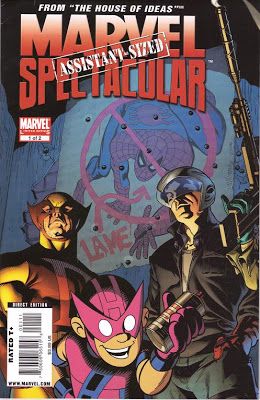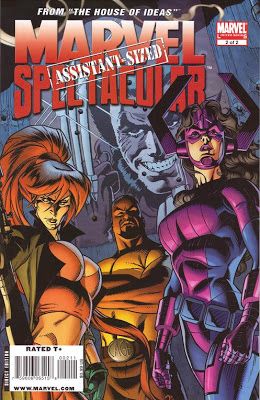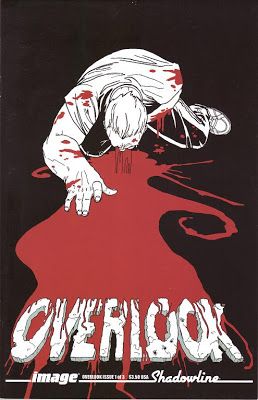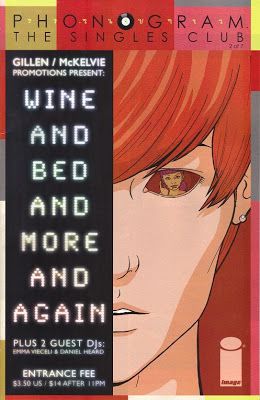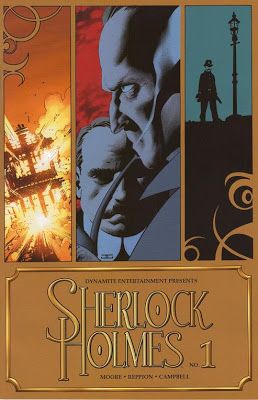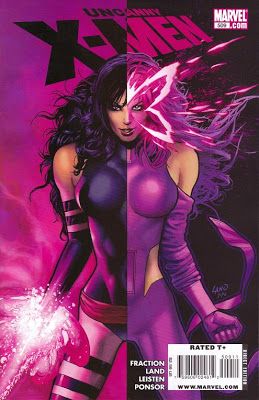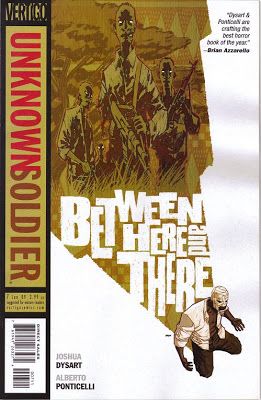This week: War comics: 2; Superhero comics: 1½. Dynamite Entertainment comics: 2; Mainstream DC comics: 0 (2 Vertigo ones, though). The best thing about this? I don't miss them at all.
Airboy - 1942: Best of Enemies by Chuck Dixon (writer), Todd Fox (illustrator), Lito Fernandez (illustrator), Val Staples (colorist), and Josh Aitken (letterer). $6.50, 50 pgs, FC, Moonstone.
You know, if more statuesque raven-headed women wore fur-trimmed capes, shirts that were open in the front all the way down to the crotch, and jodhpurs, the world would be a happier place. Even if she is a lousy Nazi.
Chuck Dixon is the perfect writer for this comic - except for Garth Ennis, he's probably the best war comic writer around right now. In this giant issue, he tells a very straightforward adventure story that should surprise no one but succeeds in being entertaining. Our hero is Airboy, who has a long publication history, and who doesn't like to be called Airboy. He's escorting a bombing run over Poland in 1942 when they're attacked by a squadron of Nazis led by Valkyrie, that buxom woman on the cover and Airboy's old nemesis. This is, however, their "first" meeting, so when Airboy downs Valkyrie's plane and then sees that she's about to be - ahem - manhandled by Russian soldiers on the ground, he lands and saves her. Unfortunately, he's bashed over the head by his erstwhile Russian allies and taken to a prison camp, where the crew of one of the bombers is being held as well. Airboy feels it's his duty to rescue Valkyrie before the Russians take liberties with her (when an American says, "She's the enemy" to him, he replies, "She's still a woman"). The story follows fairly predictably from there, with twists and turns but nothing all that surprising. Dixon isn't interested in fooling us - he's interested in telling a war story with a old-fashioned hero doing old-fashioned hero things, and there's nothing wrong with that.
Fox (both he and Fernandez are credited as "illustrators," but the art is consistent, so I'm going to assume Fox drew it and Fernandez inked it) has a solid line that reminds me a bit of Sergio Cariello (whom Dixon worked with on The Iron Ghost, another World War II comic). Like the story, it's not fancy - it gets the job done and has a bit of flair. Fox/Fernandez do an interesting thing with Valkyrie, too - they give her a bit of an overbite, which adds just a touch of menace to her, as befits a Ratzi. It's an odd stylistic choice, but it works - she's still sexy, but we know she's evil - good girls would have gotten orthodontia!
All in all, this is a fine adventure tale. It breaks no new ground, but it doesn't have to. Dixon, Fox, and Fernandez tell a rousing war story, and although it's always difficult to ignore what we know about what the Nazis were doing whenever there's a sympathetic Nazi in a comic, Dixon does a nice job with the chemistry between Airboy and Valkyrie. And, in the Golden Age comics, she eventually defected, so there's that.
Atomic Robo: Shadow from Beyond Time #1 (of 5) ("Horror on Houston Street" with the back-up story "Once Upon a Time in Mexico") by Brian Clevinger (writer), Scott Wegener (artist), Ronda Pattison (colorist), and Jeff Powell (letterer). Back-up story by Brian Clevinger (writer), Laurenn Pettapiece (artist), and Jeff Powell (letterer). $3.50, 22 pgs + 5-pg back-up story, FC, Red 5 Comics.
I'm quoted in the latest issue of Atomic Robo, and it's one of my favorite lines: "You have nothing to lose except your cynicism" if you read this comic. Well, it's time once again for another mini-series starring Nikola Tesla's greatest creation, and it's time once again for me to pimp the hell out of it. I wouldn't do it if it weren't so awesome, but luckily for my integrity, Clevinger and Wegener continue to dazzle us with said awesomeness. Clevinger is in full hilarious mode for this issue, as Robo is visited one night in 1926 by two men who are looking for Tesla and are very disappointed when Robo tells them he's on a speaking tour. Before we even know who the men are, we're laughing at the tall, nervous one's manic speaking manner, with his talk of faceless gods, mongrel hordes, "Anglo-brains," and grumpiness about not being published. Yes, the nervous man is Howard Phillips Lovecraft, while his companion is Charles Fort (star of his own mini-series a few years ago, nicely drawn by Frazer Irving), and they need to discuss a big problem with Tesla. Unfortunately, that big problem is an alien that exists throughout time, so when they thought they destroyed it in 1908 (in Tunguska, which leads to the funniest two panels in the book, as Tesla tells Robo, in a flashback, what to do if two men speaking of Tunguska ever show up), they really didn't. Bad things are afoot in the night - why didn't anyone listen to Lovecraft????
This is a wildly entertaining and very funny issue, and Wegener, as usual, draws the crap out of it. I mean, until the alien manifests itself, it's basically three human-sized figures standing around and talking, but Wegener makes Lovecraft such a paranoid goofball and, impressively enough, makes Robo look world-weary even though his face has no expressions. And his alien is nicely creepy, too.
Anyone who has ever felt a bit burned out by whatever killfest DC or Marvel is publishing right now needs to buy an issue of this comic. I don't know how long Clevinger and Wegener will be able to do this series until the Big Two come, put them on X-Force or Teen Titans, and suck out their very souls, but that's why you need to buy these issues now! Come on - where else will you read the line "We have to kill Howard Phillips Lovecraft"? Not in the latest issue of Green Lantern, I'll tell you that much!
Battlefields: The Tankies #1 (of 3) ("Sugar Sugar") by Garth Ennis (writer), Carlos Ezquerra (penciller), Hector Ezquerra (inker), Tony Aviña (colorist), and Simon Bowland (letterer). $3.50, 22 pgs, FC, Dynamite Entertainment.
I wasn't expecting this arc to be as good as "Dear Billy," because when it was announced, it sounded like what it is - a tank battle, meaning Ennis ditches some of the subtlety he employed with the last arc and kills people in magnificently depraved ways (well, not as depraved as he kills them in Crossed, I suppose, but people still get blown apart in this issue, so there's that). There's a bit of a subtext, as a wounded Waffen SS officer (from which the title of the issue comes, by the way) kills the Brit who's trying to help him, so the Brits decide they don't need to take any prisoners anymore, and I'm sure there will be more horrors in store for the tank squad whose lieutenant loses his head on page 1. It's a step down from the previous arc, but it's still entertaining if you like Ennis. Ezquerra's art is always a pleasure to see as well.
The Literals #1 ("Start as Deep in the Story as You Can") by Bill Willingham (writer), Matthew Sturges (writer), Mark Buckingham (penciller), Andrew Pepoy (inker), Lee Loughridge (colorist), and Todd Klein (letterer). $2.99, 22 pgs, FC, DC/Vertigo.
This continues to be an odd crossover, as this issue, which is a book created specifically for said crossover, focuses on Kevin Thorn for the most part, although the Fables looking for him get some screen time, as does Jack Frost. Thorn wanders around with a dude in a strait jacket (who is he?), rewriting reality and getting advice on how to recreate the universe from various literary genres. In the end, he shows why the Fables have no chance against him. So how on Earth are Willingham and Sturges going to stretch this out for nine issues? I don't know. It feels like one of the weaknesses of this crossover - we still have six issues left, and all Thorn has to do is write something and it becomes reality. I'm sure the writers have it all planned out, but I'm damned if I know how they're going to do it. I guess that's cool. This feels a bit padded, though (do we really need the entire page of that dude ordering food?), so I hope it picks up a bit.
Marvel Assistant-Sized Spectacular #2 (of 2). "Big Assist" by Chris Eliopoulos (writer), Jacob Chabot (artist), and Dave Sharpe (letterer); "Citizen Cage" by Wyatt Cenac (writer), Todd Nauck (artist), Rain Beredo (colorist), and Joe Caramagna (letterer); "Galacta; or, The World-Eater's Daughter" by Adam Warren (writer), Hector Sevilla Lujan (artist), and Simon Bowland (letterer); "Daddy's Little Girl" by Chris Yost (writer), Jon James (penciler), Victor Olazaba (inker), Ulises Arreola (colorist), and Dave Sharpe (letterer). $3.99, 32 pgs, FC, Marvel.
I put the two covers of this together because they form a complete picture. I like that the lesser-known characters were shooting at Frank Miller's Wolverine.
No story in this issue can close to the genius that is Chris Giarrusso's Hawkeye story in issue #1, but they're not bad. I could live without the story of Galactus' daughter, mainly because nothing happens, but the Luke Cage story, written by comedian Wyatt Cenac (I wonder if they'll mention it on The Daily Show), isn't bad, although the fact that Marvel won't let Cenac write "ninja shit!" dulls the impact a bit. It's always nice to see Elsa Bloodstone, especially when she's puking up baby monsters and then stepping on them. The funnest part of this issue is when Joey Q shows up at the end with his lackey Dr. Doom and announces that you can go to Marvel's web site and vote for your favorite story, which will then get a continuation. This is our chance to crash Marvel's site with demands for Chris Giarrusso to TAKE OVER THE MARVEL UNIVERSE! Remember, when things look down, just follow Chris Giarrusso's awesome new character's advice:
Let's hope Giarrusso wins. No offense to any of the other stories, but his kicks ass.
Overlook #1 (of 3) by Joshua Williamson (writer) and Alejandro Aragon (artist). $3.50, 22 pgs, BW, Image/Shadowline.
Overlook came out two weeks ago (I think), but I didn't get it until this week through a combination of circumstances that I'm sure nobody, including me, cares about. But here it is!
There's nothing spectacular about Overlook, which doesn't make it a bad comic. It's firmly in a grand noir tradition, and while it's not as good as, say, Criminal, there's nothing really wrong with that, as Criminal is really, really, really good. But whereas the skill Brubaker and Phillips bring to Criminal might make fans of people who weren't all that into noir, Overlook probably won't win any new ones. I, however, am a fan of noir, so I enjoyed this. If you're a fan, you'll probably like this.
The story concerns Mickey "The Nickel" Nicholson, who fights in bare-knuckle brawls that he knows he'll lose (he specifically says he doesn't throw fights, he just fights people who are better than he is) to get some money for the next drink. One night a mysterious stranger takes him to an estate, where a retired mobster has a proposition for him. He wants Mickey to kill his wife, who has fled town with his brother and 20 million dollars. In return, he will have his manservant kill anyone Mickey wants dead. There's a funny bit where Mr. Corletti, the mobster, tries to reference Strangers on a Train, but Mickey doesn't know the movie, so Corletti references Throw Momma From the Train instead. His wife and brother have gone to the town of Overlook, where, we learn after Mickey has left, some strange things are going on. Mickey takes the job because he was once a cop, but his wife and his partner turned him into Internal Affairs because he was crooked. This is a chance to get out of his lousy life, as Corletti promises him some of the money that the targets fled with. Yes, this is a total recipe for disaster. It's a noir comic - of course it's a recipe for disaster!
Williamson does a decent job getting all the information to us that we need without dragging the story down too much, and Aragon has a Eduardo Risso vibe going on (he's not as good as Risso, though), which obviously fits the story well. Yes, it's derivative, but that doesn't mean it's not entertaining. With comics like this, it's all about watching the anti-hero spiral into the crap and then seeing if he can somehow salvage it all. We'll see what happens with Mickey.
Phonogram: The Singles Club #2 (of 7) ("Wine and Bed and More and Again" with the back-up stories "Wuthering Heights" and "The Singer") by Kieron Gillen (writer), Jamie McKelvie (artist/letterer), and Matthew Wilson (colorist). "Wuthering Heights" by Kieron Gillen (writer) and Emma Vieceli (artist); "The Singer" by Kieron Gillen (writer) and Daniel Heard (artist). $3.50, 16 pgs + 4- and 2-pg back-up stories, FC, Image.
The second issue of Phonogram is a bit late (the first came out in December), but as this mini-series is a group of single-issue stories, it doesn't matter that much beyond the obvious of wanting to read Gillen and McKelvie's fantastic comic. Yes, some people at this here blog have expressed the fact that they don't "get" Phonogram, but, I'm sad to say, those people are degenerate Marxists who kick puppies, and we don't want to be associated with them. What's not to get about Phonogram? Especially with the first two issues of this series, as Gillen and McKelvie have really hit all the right notes. In the first series, which was more plot-driven, Gillen was working out some kinks. But so far in this series, he's given us two devastatingly honest stories about real people, and even though the stars of this series are young punks and therefore I, as an elderly curmudgeon, ought to loathe them, Gillen gives them such real problems that we just can't help falling in love with them. This issue, for instance, is simply the tale of a relationship gone bad, viewed through the prism of "curse songs" - tunes that are linked to that relationship, so when they're played, you relive it - and Gillen turns it into something deeper even as we just get the superficialities of the relationship. It's a nice trick - Gillen doesn't have to worry about writing "deep" dialogue and he gets in some funny lines while relying on his partner in crime to add depth to the affair with his art. McKelvie, of course, is brilliant, and this is part of why. Both McKelvie and Gillen have been doing some work for Marvel recently, and although neither has embarrassed himself, their work feels a bit ... corporate, I guess, for lack of a better word. It's nice that they're getting higher profile work, but then an issue of Phonogram comes out (or possibly, Mr. McKelvie, a second series of Suburban Glamour?), and we're reminded just how talented both guys are. They've promised that the series won't experience any more delays. That would be nice, but this is one series worth waiting for.
For what it's worth, KG, I'm also intimidated by being on the same planet as Diamanda Galas. Ms. Galas makes music that actually scares me.
Sherlock Holmes #1 (of 5) ("The Trial of Sherlock Holmes: A Smoking Gun") by Leah Moore and John Reppion (writers), Aaron Campbell (artist), Tony Aviña (colorist), and Simon Bowland (letterer). $3.50, 22 pgs, FC, Dynamite Entertainment.
I have recently become a Holmes aficianado (not to the extent of the people who think he's real and still lives in Tibet or somewhere, but still - I'm a fan) - I read The Hound of the Baskervilles when I was a lad and some random stories here and there, but only recently have I plowed through every Conan Doyle story and really become interested in some of the fan fiction that's out there, so I was happy to see a new Holmes comic, and a well done one at that. There's a bombing in the East End, a visiting dignitary (a Merovingian, from the sound of his name, which makes this Merovingian scholar giddy), and a man who has asked Holmes for help when he receives a death threat. These three things all seem linked somehow, but we'll have to wait to find out more! Holmes and Watson stand guard at the house of the man who received the death threat, and right before the appointed hour (Joker-style, the letter-writer named the time of death), the man, who's dying of consumption, calls Holmes into his bedroom. At seven o'clock, there's a gunshot from the bedroom, and when the police break in, Holmes is standing over a dead man, gun in hand. Oh dear.
Now, the logical conclusion to reach is that Sir Samuel, the victim, begged Holmes to kill him because he didn't want a slow, lingering death from consumption (that's a nice touch by the writers, as Conan Doyle's first wife died of consumption). We'll have to see if that's the way it is. This is a somewhat slow-moving issue (yes, a bomb goes off on page 2 and Sir Samuel gets killed, but there's a lot of talking in between), but it has a decent pace and feels tense, as it appears clues are being dropped all over the place. We'll see. The only thing I didn't like was that Holmes seems scared and clueless when the cops break in at the end, which is somewhat at odds with the Holmes we know and love. I'm not sure if Moore and Reppion will address this, but it bugged me.
Campbell does a pretty good job with the art. Holmes doesn't wear a deerstalker hat, which is nice. The panel in which he stands over Sir Samuel's body is disconcerting, because he does a good job making Holmes look scared, which simply doesn't jibe with what we know about Holmes. But Campbell does a good job with it, at least.
I'm looking forward to see how Moore and Reppion tie it all together. It's always fun to read a good Holmes story, and this one has potential.
Uncanny X-Men #509 by Matt Fraction (writer), Greg Land (penciler), Jay Leisten (inker), Justin Ponsor (colorist), and Joe Caramagna (letterer). $2.99, 22 pgs, FC, Marvel.
You know how you have favorite comic characters, and although you wish those characters would show up more often, you fear that a writer just isn't going to "get" what's great about those characters? That's how I feel about my three favorite X-characters - Rogue, Psylocke, and Dazzler. Rogue has been prominent in the X-books for so long that I have moved past that feeling, but Psylocke and Dazzler were in limbo for so long (we can ignore Betsy's time in the Exiles, because that's easy to discount) that now that they're back, I fear that Fraction will "ruin" them. He doesn't do much with either of them in this issue, but I'm worried he's going to make Psylocke some kind of villain, and that just bugs me. I just hope he gets past this storyline quickly, adds Betsy to the team, and figures out what to do with her. We'll see.
As always, I'm terribly ambivalent about this comic. "Just drop it already!" you yell, but as always, it's not horrible, and it's occasionally very good, so it's tough to figure out. I honestly don't know from page to page whether it's going to suck or shine, which makes for a really weird reading experience. The X-Club stuff remains the strongest part of Fraction's run, to the extent that I really wonder how much of the rest of it is a tiny bit editorially mandated. (Before anyone jumps all over me, I'm not saying Joey Q is standing over Fraction's shoulder forcing him to put Madelyne Pryor in the book. I'm just wondering if Fraction pitched a different idea, one that focused on Henry McCoy and his little group a lot more, and editorial told him he could do that if he, I don't know, brought back Magneto. Fraction has proven that he's a forward-looking kind of writer, so the fact that he's - like every other person who writes this book - recycling ideas is distressing. I would love to write the X-Men, but I have no interest in writing a Magneto story, for instance. Is this book a compromise? Beats me. All I know is that Fraction seems a bit bored with some of the plots. If they're his plots, why is that?) The rest of it is plodding along, as Maddie explains the Betsy/Kwannon situation for those who were lucky enough to miss it the first time around and then explains that she's going to jump into a new body herself. The Chick Brigade then invades the X-HQ and takes everyone down really quickly. That's some hi-tech security they have at the HQ, ain't it?
There are, of course, some things that bug me about the issue. The first six pages annoyed me for a few reasons. The clichéd version of San Francisco as a place where everyone loves everyone else and everyone can let their freak flag fly bugs me only because Fraction has been so relentless at telling us it's this way without really showing it to us. Yes, we get panels of Colossus at a Raiders game (Oakland, I suppose, is just as loving as its wacky sister city across the bay) and other X-folk hanging out on the street, but it feels fake. The problem with big-time mainstream comics these days, it seems, is that we rarely get issues where everyone takes a breather. Why not a complete issue of a few characters roaming the city, where nothing horrible happens? That would give a better view of how San Francisco really thinks of the mutants, rather than just telling us everything is rosy. Then we get Trask introducing a proposition to neuter mutants. These are the kinds of things that always bother me in the Marvel U., because Marvelites want us to believe that the Marvel U. is oh-so-similar to our world, but it's really not. Can you imagine someone getting in front of cameras and announcing a proposition to neuter Muslims? He'd be laughed off the television. In the United States, where a majority, I would bet, consider homosexuals weird, there's a very loud debate over whether gay people can marry. In Arizona, a fairly conservative state, proponents of a gay marriage ban had to reword a proposition against gay marriage because the first time around, it was so obviously oppressive that even Arizonans didn't pass it. It passed in the last election (I'd be ashamed, but I don't like Arizona anyway, so whatever), but barely. And that's for something (a ban on gay marriage) that a lot of people want but are justifiably wary about enshrining in a constitution. Legislation to neuter a group of people is ridiculous, and worse than that in the context of this comic, it won't go anywhere. Fraction will bring it up a few times, but because it's a short-attention span world, the idea of debating this for years - which is what would happen - won't come up. This kind of government interference was annoying when it was Bastion rounding up mutants for no reason, and even though Fraction is a better writer than those on the X-books back in the day, that doesn't mean he can make stuff like this work.
Finally, one line later in the book cracked me up. Alison Blaire, who has been off the team for years, says to Scott: "Don't take this the wrong way but if you two [Scott and Emma] can't make it work then there's no hope for any of us." Jesus. First of all, Dazzler isn't really "best buds" with Cyclops. They have rarely (if ever?) been on an X-team together. So how close is she really to Scott? Second, everyone has tried so hard to make Scott and Emma this romance for the ages when it's really not, but this is laughable. "Hey, Scott, if you and Emma, who was once a villain and with whom you cheated on your wife and with whom you've been intimate for, what? a year in Marvel Time can't make your romance based, from what I can tell, on your need for a dominatrix, work, then what hope do any of us have?" Yeah, okay. Maybe Alison thought he was still with Jean? She's been out of the loop for a while, after all.
I've written so much about this I can't even mention the art. It's Greg Land. You know the drill!
Unknown Soldier #7 ("Between Here and There: A Prelude") by Joshua Dysart (writer), Alberto Ponticelli (artist), Oscar Celestini (colorist), and Clem Robins (letterer). $2.99, 22 pgs, FC, DC/Vertigo.
Do I have enough in me to write about Unknown Soldier? Sure! Let's start with new cover artist Dave Johnson. As much as I like Dave Johnson (and like that cover), I thought Igor Kordey was doing a very good job on the covers, with issue #4 being a highlight. I don't know why Kordey is no longer doing the covers, but I just thought I'd mention he did a really good job.
Dysart tells a single-issue story in this comic that follows from the first arc and leads into the next one nicely. It stars Moses, of course, but it's more about the differences among the people of Uganda, who are, after all, from different tribes. Dysart does a nice job showing how some people simply don't understand the violence that's occurring in their own country and need to be shown it up close. Despite the war-torn scene of the first arc, this quieter issue ("quieter" is relative, as people still get killed brutally) is a bit more complex than it was, because Dysart is dealing with attitudes and how blind people can be. In the first arc, the problems were more on the surface - child soldiers and what to do with them, for instance - while here, we get a brief glimpse of the psyche of a country. It's well done, and if Dysart continues in this vein, I might have to get off the fence and embrace the book. We'll see.
Ponticelli does a fine job with the art, especially on a few pages where Moses comes out of the bush and Alimo, one of the students who venture into the north from Kampala, imagines him as the angry spirit of the land. Ponticelli's art is more ethereal on these two pages, hallucinatory even, and it's amazing to look at. The rest of the book looks fine, as well, but the contrasting style works beautifully.
As I have always mentioned, I'm kind of on the fence about this book every month. It's growing on me, however, so I might have to commit to the next arc as well before making a final decision. Dysart is going in the right direction, it seems, which is nice.
I have a couple of updates before we get to totally random lyrics. I recently reviewed City of Walls and gave a link to where you could buy it. The writer let me know that there are new links: Here for the four individual issues, and here for the trade. Check them out! Also, Alex Sheikman, the creator of Robotika, let me know that if you want to order the book (it was in April's Previews, and yes, you should order it), go here and read how to order it from your comics shoppe. It's a very cool comic with stunning art. Why not pick it up?
Now, some totally random lyrics:
"I can be the sauce you crave
I can spell what you can't say
Chocolate flavor love theme
Treat the treats you so mean
Covering your nights and days"
Have a nice time marching today, you Commies!


